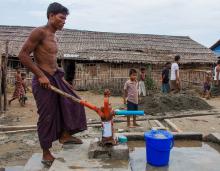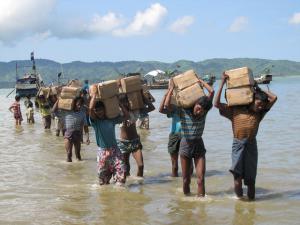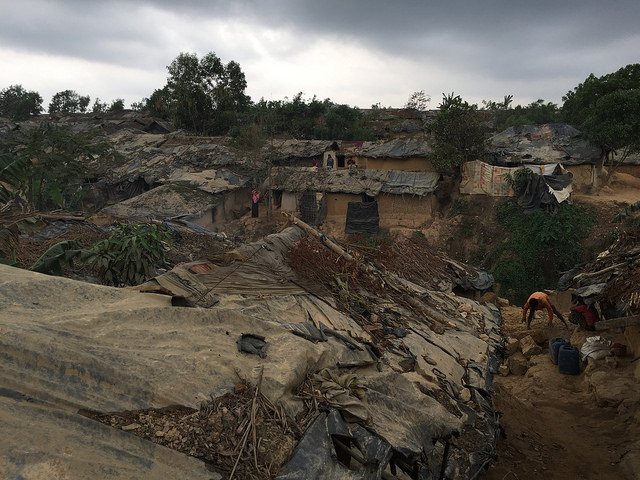The Trafficking of Stateless Rohingya: A Problem of Organised Crime or State Crime?
ASIA--PACIFIC, 31 Aug 2015
Natalie Brinham – London International Development Centre
In 2013 Natalie Birnham met and interviewed a Rohingya survivor, named Jamal, in an above-shop office of a local CBO in Kuala Lumpur. He recounted his journey fleeing from Western Myanmar/Burma to Malaysia.
27 Aug 2015 – In 2013 I met Jamal in in Kuala Lumpur. He recounted his journey fleeing from Western Myanmar/Burma to Malaysia. Jamal (all names have been changed to protect the identity of interviewees) arrived two days before, and was visibly emaciated. Twelve men from his village were not so lucky – they had died after the food and water ran out on board the boat. Jamal sobbed as he told me how he had helped throw their bodies over-board.
Jamal survived both mass state-sponsored violence in Myanmar and the now notorious human trafficking networks that operate the route from the Bay of Bengal to mainland Southeast Asia. He was, in other words, a survivor of both state crimes and of organised crime.
On route, he encountered the Myanmar Navy after the over-crowded boat he was travelling on ran out of fuel and food.
They told us to come aboard the navy boat two or three at a time. They told us to lie down flat on our stomachs with our face to the floor. They beat each of us as we lay down. We all got five lashes. Some among us could speak Burmese fluently. But those who spoke Burmese got extra lashes. They shouted, ‘Why do you speak Burmese? You are not Burmese.’ Then we were told to get back on our own boat. They gave us no food. No water and no fuel. The Navy boat towed our boat for many hours into the open sea. They confiscated our anchor. When they untied our boat, they told us Thailand is in that direction.[i]
The process of persecuting and de-nationalising Rohingya in Myanmar has intensified since he made his journey – yet by the end of May this year, the Myanmar Navy had been tasked by the international community with searching for and “rescuing” Bangladeshi and Rohingya “irregular migrants”.
So, how did it happen that the military of a government- accused by Human Rights Watch of Crimes against Humanity and ethnic cleansing of Rohingya -should be considered an appropriate body to “rescue” the very same people fleeing their persecution?
No small wonder that questions have been asked about the fate of the rescued Rohingya.
Earlier this year, the Thai government, under rising pressure, began cracking down on the “trafficking camps” where Rohingya and other migrants were held in hostage-like situations during the overland leg of the journey to Malaysia until payment was provided by relatives. The scale of the abuse, exploitation and extortion inflicted on those in the camps became apparent. Mass graves were found and evidence of rape and torture was gathered. Traffickers were arrested – amongst them government officials long complicit.
Despite over ten years of developing anti-trafficking initiatives in the region, protections for victims of trafficking remain grossly inadequate – especially where victims are stateless – and the crackdowns came at a cost for the Rohingya in transit and those needing to flee persecution in Myanmar.
As a consequence of the crackdown, boatloads of refugees and migrants were prevented by state authorities from landing in Thailand, Malaysia and Indonesia as Southeast Asian states closed down the informal routes of refuge that had previously facilitated Rohingya entry. There was an immediate humanitarian crisis for those abandoned by their agents and drifting at sea.
At the end of May this year, prominent government officials from 17 countries met in Bangkok to discuss how to resolve the immediate humanitarian crisis as well as the on-going issue of “irregular maritime movements”. In a bid to get Myanmar to the table and to extract their cooperation, the decades of persecution of the Rohingya as a root cause of the displacement was not addressed. In fact the word “Rohingya” – a term which is officially rejected by the government of Myanmar – was not even uttered in official transcripts.
Plans were made to cooperate on search and rescue and strengthen responses to human trafficking primarily through prosecution of traffickers. Meanwhile across the world at a conference in Oslo, Nobel laureates and international human rights experts discussed whether the situation for Rohingya in Myanmar constitutes genocide or simply Crimes against Humanity.
 The Bangkok meeting essentially concluded that the “migrant crisis” was due to unscrupulous individuals that were part of human trafficking networks. At the same time George Soros hit the headlines comparing Myanmar’s official segregation and persecution of Rohingya in Myanmar to his personal experience of Nazi occupation of Hungary.
The Bangkok meeting essentially concluded that the “migrant crisis” was due to unscrupulous individuals that were part of human trafficking networks. At the same time George Soros hit the headlines comparing Myanmar’s official segregation and persecution of Rohingya in Myanmar to his personal experience of Nazi occupation of Hungary.
Anti-trafficking frameworks were developed primarily to tackle cross-border organised crime. To do this, they broadly focus on Prosecution, Protection and Prevention. The aim is to prevent trafficking by prosecuting criminal individuals, educating populations about risks and sometimes by providing safe migration alternatives through bilateral agreements between states. Where victims are stateless, and have also experienced state crime in their countries of origin, such frameworks are impotent. Meetings about the migrant crisis in the Andaman seas took the root cause of the crisis and displaced it from the primary arena of state crime into the secondary realm of international crime syndicates.
Rohingya are extremely vulnerable to organised crime abroad because they are fleeing state crimes at home. The UN Special Rapporteur on Human Trafficking recently noted that refugees and asylum seekers are at increased risk of trafficking and many will leave home knowing they may be exploited.
Mohammed, the uncle of another Rohingya youth I met in KL – who was too traumatised to recall his experience of torture in a trafficking camp on the Thai/Malaysia border that rendered him unable to walk – explained this to me in his own way. In the recent past Rohingya leaving Rakhine State for Malaysia would generally have time to gather financial resources and the support of relatives overseas before getting on the boats. These days they are compelled to leave with urgency and desperation, without resources or contacts –just as his nephews did.
This leaves them more vulnerable to exploitative agents. Mohammed, having initially refused to pay the ransom, was lured into coming to pick up this young nephew’s dead body for burial – only to have the ransom fee extorted in order to take him home, crippled but alive. A week later and the evening before I met Mohammed, he was contacted by agents demanding payment for his two other nephews. He wasn’t sure where the money would come from. He was desperate – the agents, he told me, were resorting to increasingly cruel measures to extract payment.
Despite Myanmar’s state crimes being established as the root cause of the displacement of Rohingya by numerous human rights organisations, policy remedies for the trafficking of Rohingya only tackle organised crime. The tragic outcome of such an approach is that desperate Rohingya are finding it harder and harder to leave Myanmar. The fire door has been blocked off and no equipment has been left to fight future fires.
The risk of mass violence against the Rohingya and other Muslims in Rakhine State is increasing ahead of Myanmar’s scheduled elections in November, with the intensification of the de-nationalisation process and the enacting of more discriminatory laws. If lessons from the past are learnt, there is one sure way to increase the risk of a situation of ethnic cleansing turning into one of mass killing – and that is to shut off escape routes.
Of course the killing, torture, rape and extortion of Rohingya on route to a safe country should never be allowed to go unprosecuted. However, there are real risks that come with prosecuting traffickers when the result is to close escape routes. When anti-trafficking frameworks in the region do not provide adequate protections for victims and when organised crime is tackled without addressing the root causes of displacement – namely persecution – it is the victims that pay the ultimate price, not the traffickers.
We don’t yet know what price Rohingya in Myanmar will pay for the crackdown on trafficking syndicates. We do know that for Rohingya and other stateless or persecuted persons, anti-trafficking frameworks are never going to muscle-up unless they are integrated into approaches that also tackle the primary cause of victims’ flight: state crime.
NOTE:
[i] Interviews I conducted as part of my work with Equal Rights Trust. Also quoted in Zarni, M. and Cowley, A. (Natalie Brinham’s pseudonym) “The Slow-burning genocide of Myanmar’s Rohingya”, Pacific Rim Law & Policy Journal, University of Washington, volume 23 no.3, June 2014.
___________________________________________
Natalie Brinham studied an MA in Education, Gender and International Development while working as a Senior Support Worker with women trafficked into the UK. Since graduating in 2009, Natalie has continued to blend front-line support work for refugees, migrants and survivors of trafficking with research and advocacy. From 2011 to 2015, Natalie worked as a consultant on the Equal Rights Trust’s statelessness projects, based in London, Brunei and Malaysia. Natalie co-authored a study with Maung Zarni, entitled “The slow-burning genocide of Myanmar’s Rohingya”, under the pseudonym Alice Cowley which was published in the Pacific Rim Law and Policy Journal. This continues to be used to advocate for better protection for Rohingya and Myanmar Muslims at international conferences. She was recently awarded a PhD scholarship at the newly formed UK Institute of Migration Research in Canterbury exploring the topic of life after trafficking: short and long term outcomes for survivors of trafficking in the UK.
DISCLAIMER: The statements, views and opinions expressed in pieces republished here are solely those of the authors and do not necessarily represent those of TMS. In accordance with title 17 U.S.C. section 107, this material is distributed without profit to those who have expressed a prior interest in receiving the included information for research and educational purposes. TMS has no affiliation whatsoever with the originator of this article nor is TMS endorsed or sponsored by the originator. “GO TO ORIGINAL” links are provided as a convenience to our readers and allow for verification of authenticity. However, as originating pages are often updated by their originating host sites, the versions posted may not match the versions our readers view when clicking the “GO TO ORIGINAL” links. This site contains copyrighted material the use of which has not always been specifically authorized by the copyright owner. We are making such material available in our efforts to advance understanding of environmental, political, human rights, economic, democracy, scientific, and social justice issues, etc. We believe this constitutes a ‘fair use’ of any such copyrighted material as provided for in section 107 of the US Copyright Law. In accordance with Title 17 U.S.C. Section 107, the material on this site is distributed without profit to those who have expressed a prior interest in receiving the included information for research and educational purposes. For more information go to: http://www.law.cornell.edu/uscode/17/107.shtml. If you wish to use copyrighted material from this site for purposes of your own that go beyond ‘fair use’, you must obtain permission from the copyright owner.

